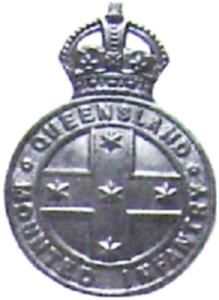Topic: Militia - LHQ - Qld
Queensland Mounted Infantry
Outline, Part 1

Forward
March: Soldiers of the Queen
Allied with: King Edward's Horse (The King's Oversea Dominions Regiment).
The following outline of the Queensland Mounted Infantry is extracted from a book written by Joan Starr called Forward: the history of the 2nd / 14th Light Horse (Queensland Mounted Infantry), published Queensland, 1989. This section comes from pp. 1 - 3:
From the landing of the First Fleet to the late nineteenth century, Australia was a temporary home for over a quarter of the line regiments of the British Army. In the days when the Regiments of Foot were still numbered, twenty-six of them served in the Australian Colonies. Apart from ceremonial duties their responsibilities were largely of policing: guarding convict chain gangs and jails; protecting settlers from the Aborigines and bushrangers; and protecting the goldfields and gold consignments, and so on. Although many Australian born men were recruited into the British units stationed in Australia, the colonies' defence and internal law were in the hands of the British Army.
In the mid-nineteenth century, as British units were disbanded and the troops withdrew from Australia, the colonies faced the task of raising and funding a standing army of their own, and of coordinating a defence policy. Following the separation of the Colony of Queensland from New South Wales in June 1859, steps were taken to provide for its defence. The responsibilities assumed by the new and sparsely populated colony included the defence of its 3,000 mile coastline, and its vast 670,500 square miles - an area as large as Great Britain, Ireland, France, Spain, Portugal, and Italy combined. For a population of only twenty five thousand, almost one third of which was concentrated in the southeast corner in Brisbane and Ipswich, this was a formidable task. Furthermore the small detachment of Imperial troops had been withdrawn some years earlier so the Colony lacked even the nucleus of a defence organisation upon which to build.
In early February 1860, the Colonial Secretary announced in the Moreton Bay Courier that lists were open for the enlistment of one troop of twenty-five Mounted Rifles and two companies of fifty Riflemen each. All men were to be volunteers and the Mounted Rifles were to supply their own horses and uniforms, the government undertook the supply of weapons and ammunition. The volunteers were to be paid only if called out for service and provision would be made for the families of any men killed in action. It was considered that, "two hours daily on two days of the week would suffice for drill and practice, or even Sunday evenings alone. Such practice would be a healthy and agreeable exercise and would promote sociability and good feeling.
The birth of the unit that is now known as the 2nd/ 14th Light Horse (Queensland Mounted Infantry) occurred on 27 February 1860, when the Governor, Sir George Bowen, approved the Rules and Regulations of the Brisbane Mounted Rifles. The Governor appointed John Bramston as Captain and commander of the troop. Later that year two more troops of the Queensland Mounted Rifles were raised and known by their district titles of Ipswich and Port Curtis.
Following an enthusiastic start the Volunteer Defence Force experienced difficulty retaining its recruits. Within two years the numbers in certain units dwindled due to a lack of interest, and dissatisfaction caused by the government's failure to provide sufficient uniforms and equipment. In March 1863 the Governor dispensed with the services of the Port Curtis troop due to their failure to attend parade, the commissions of the officers were cancelled. The Queensland Mounted Rifles were renamed Queensland Light Horse in 1864, but their numbers continued to dwindle with the troops at Brisbane and Ipswich numbering twenty-five. The Moreton Bay Courier noted that they were the most irregular troops of an unorthodox army. The men were said to be loath to accept discipline and their only usefulness was for the purpose of show. The paper predicted an early disbandment of the remaining mounted troops. Unfortunately, their prediction was accurate and by 1866 both the Brisbane and Ipswich troops had been disbanded. Queensland had chosen, for reasons of economy, to create an amateur defence force. It would take many years for the government to realise its mistake, but in the meantime the Queensland Defence Force continued under difficulties and by 1876 the total number was only 415 men enrolled in artillery and infantry units.
This was all to change as fears of a Russian invasion and concerns over unrest in the Torres Strait region caused a government rethink of its defence policy. In September 1883 an Imperial officer, Lieutenant Colonel George Arthur French, Royal Artillery, was appointed as Commandant of Queensland's Defence Force. French was a committed militiaman who wanted to eliminate the volunteer force completely and create a militia force, or at least one that was partially paid. Although he was not allowed a completely free hand in reorganising the force, French did however generate considerable change in the government's attitude to defence. A professional, he expressed himself forcefully and he would not be ignored when presenting his reports criticising a lack of government action. He had no intention of tolerating indifference and his dynamism had effect.
The Queensland Defence Force was substantially reorganised under the 1884 Defence Act with £35,591 allocated for the 1885-86 year. Under the reorganisation the new Volunteer Corps was gazetted on 4 March 1885. The old volunteer units, with the exception of a few in the country areas, were converted to militia, or paid army. The militia component of the Defence Force had a strength of 110 officers and 1,528 other ranks.
French distinguished between the paid and unpaid forces by calling the militia "Defence Forces" and labelling the unpaid troops "Volunteers". Within three years he had increased the Volunteer Corps to 26 officers and 718 other ranks. Included in the volunteers were the Brisbane Mounted Infantry (renamed Moreton Mounted Infantry in 1885), Bundaberg Mounted Rifles, Gympie Mounted Rifles, Mackay Mounted Rifles, and Charters Towers Mounted Infantry. The 1884 Defence Act and Lieutenant Colonel French had provided Queensland with a stable defence structure, among its finest troops were the mounted soldiers.
Previous: Queensland Mounted Infantry
Next: Queensland Mounted Infantry, Outline, Part 2
Further Reading:
Boer War - Queensland Mounted Infantry
Australian Militia Light Horse
Citation: Queensland Mounted Infantry, Outline, Part 1



